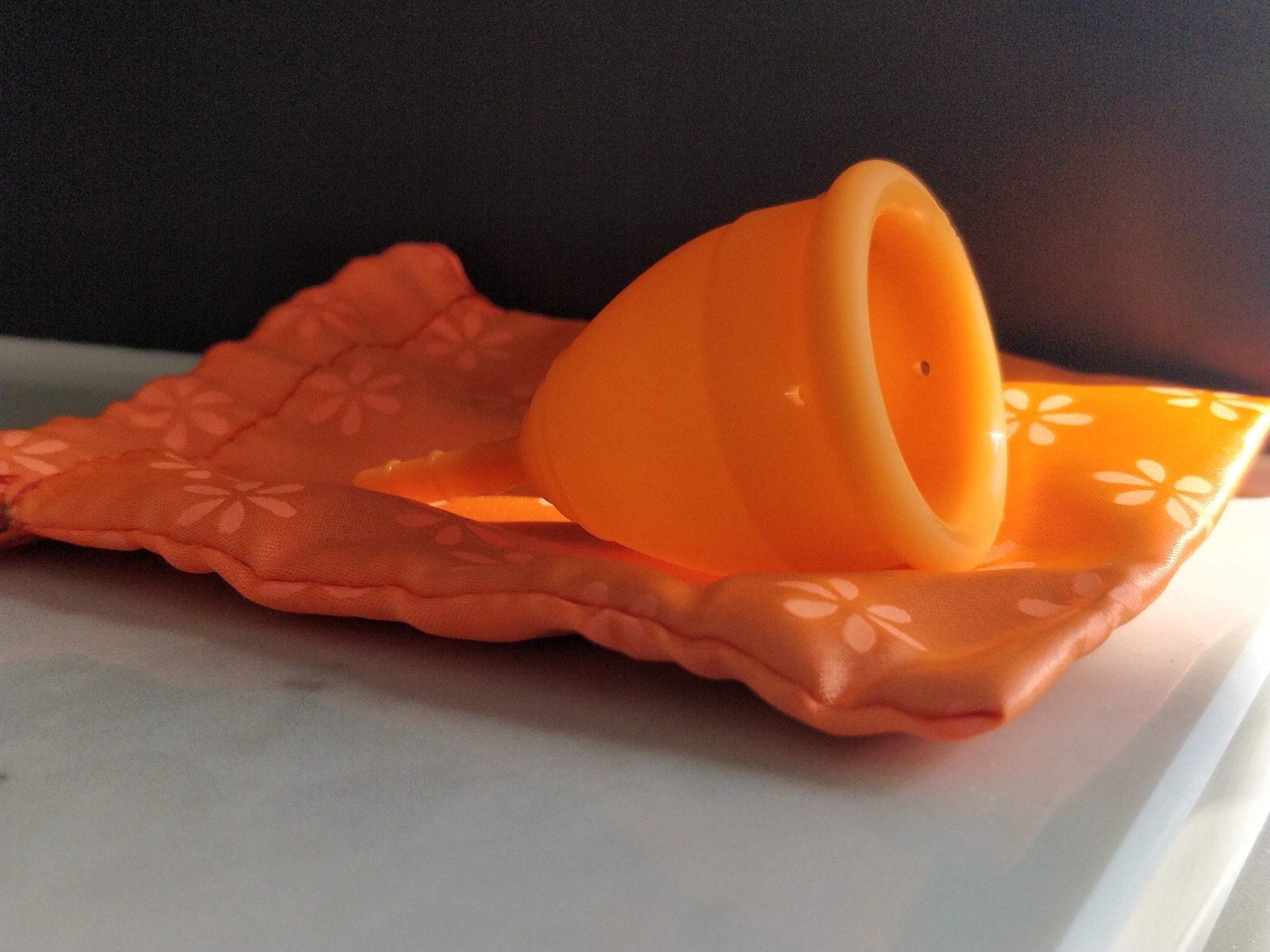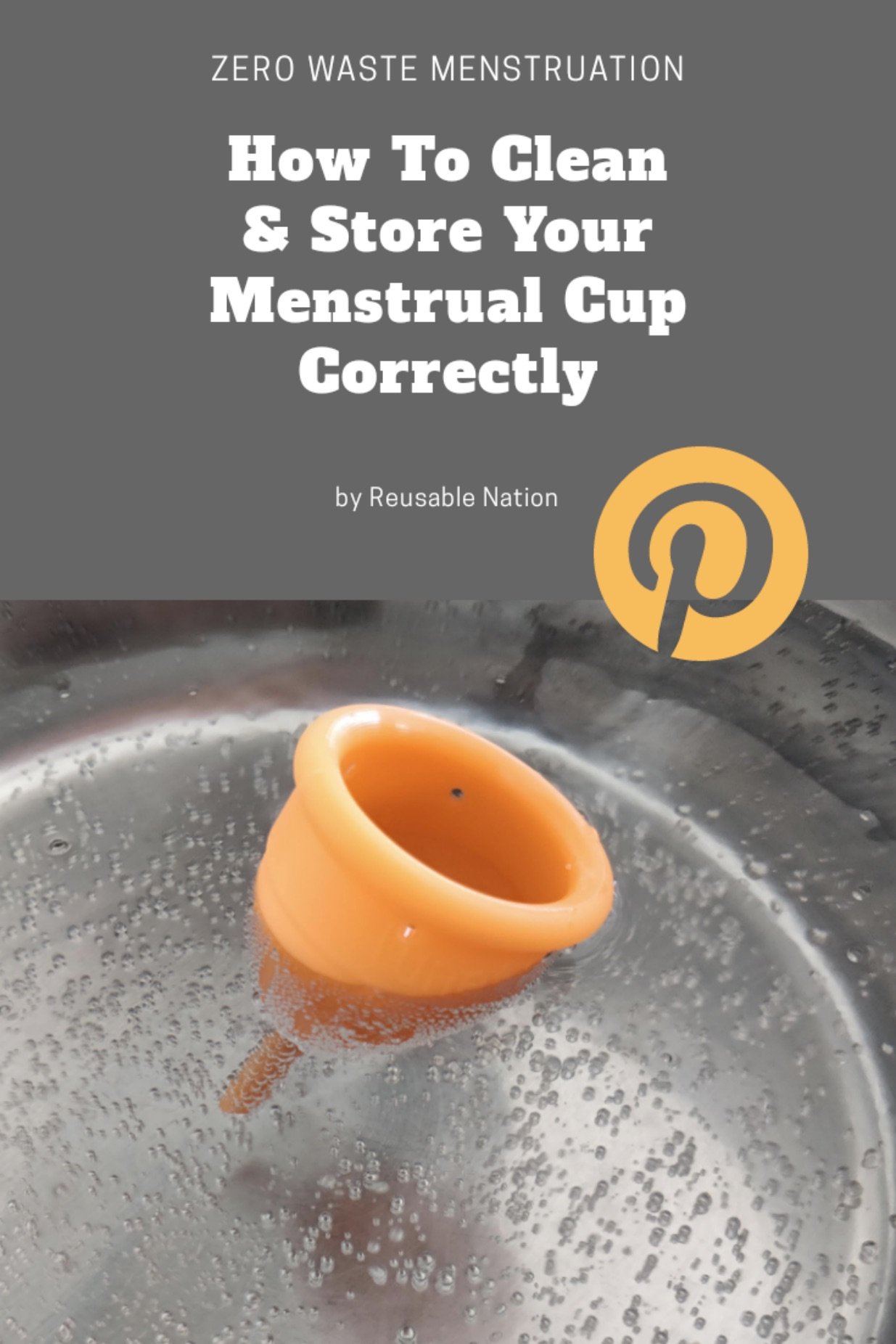How To Clean & Store Your Menstrual Cup Correctly
Properly cleaning and storing your menstrual cup is vital to keep your vagina healthy and your menstrual cup in good condition. Find out how to clean and store your menstrual cup correctly, and how to prevent and get rid of stains and smells.
JUMP TO:
Although not common, it is possible to get toxic shock syndrome (TSS), which is an infection caused by bacteria that enter the body through a mucous membranes or wound, from a period cup that is not properly disinfected.
You can also ruin your menstrual cup by using the wrong soap to clean it, letting it get stained and letting it acquire a smell, and burning it while sterilising it.
This can be successfully avoided by making sure you are following the proper process when it comes to sterilising your menstrual cup after and before use, disinfecting it between uses, and storing it.
If you are still considering whether a menstrual cup is the zero waste menstruation method for you, read our Zero Waste Menstruation: Non-Trashy Menstrual Products for a Waste Free Period article to find out what other options there are, how to choose a menstrual cup, and which brands we recommend.
Follow the cleaning instructions given
Firstly, you should always follow the manufacturer’s instructions on how to look after your period cup.
Most good brands will come with an instruction sheet that explains exactly how to sterilise it before use, insert it, remove it and clean it between and after use. Follow these exactly and you shouldn’t go wrong.
In general, these instructions are:
sterilise it before using it for the first time by washing it in warm water with a mild, unscented, water-based soap, rinsing it and boiling it in a pot in a good amount of water (so it doesn’t burn) for 20 minutes
clean it before your cycle, every time after you empty it, and after your cycle
wash your hands well before touching your menstrual cuprinse in cold water first so it doesn’t become discoloured or start smelling
after rinsing in cold water, wash with hot water and a mild, perfume-free, oil-free soap or a dedicated menstrual cup cleansing wash
you can gently stretch your menstrual cup’s holes under warm running water to remove any debris that may be inside them
sterilise it after you have finished your period by boiling it in a large pot of water for 5 to 10 minutes
don’t use a menstrual cup for more than 12 hours at a time – it needs to be emptied and washed at least twice a day i.e. at least every 12 hours, but ideally every 4 to 8 hours
Some people use a microwave cup steriliser to sterilise their menstrual cup instead of boiling it in a pot on the stove. Some use their regular pots and some use a dedicated pot, mainly just because of perception. Using your regular pot is fine.
Let it air dry once sterilised. I usually do this in the sun, as it has antibacterial properties and it dries quickly.
What soap to use to clean your menstrual cup
To clean your menstrual cups, using a soap that is mild, unscented, oil-free and water-based is recommended. This is important because the wrong soap can coat the cup in a film that is difficult to get rid of, it can disrupt the bacteria and pH of the vagina, and it can irritate the vagina, which is sensitive to soap.
So, what soaps are mild, water-based, and fragrance and oil free? Examples are:
Cetaphil soap (note that the bars come in sneaky hidden plastic wrap inside the box (if you have a few minutes please email them and ask them to change this! If enough of us email them they might))
Dermaveen soap-free cleansing bar (AU) (same as above in a cardboard box but wrapped in plastic)
Liquid Neutrogena soap (US/CAN)
You can also use sex toy cleaners as they are safe for use on silicone and for your intimate areas.
Some brands do sell dedicated menstrual cup cleansing wash, such as:
Lunette Feelbetter Cupwash menstrual cup cleanser (AU here and US here)
OrganiCup OrganiWash (UK here)
Pixie Menstrual Cup Wash (most countries here)
These are specifically formulated to clean and protect these cups and keep your vagina happy. They all come with plastic packaging, unfortunately.
You can also get cleaning wipes that can be useful when you need to clean it in a public bathroom or are camping or travelling, as the water used to wash and rinse it needs to be potable (safe to drink). Read more about them under the Cleaning Your Menstrual Cup In a Public Bathroom and When Travelling subheading below.
Many people use pure unscented castile soap like Dr Bronner’s pure castile liquid soap baby unscented, which can be bought in AU here, in CAN here, in the UK here, and in US/other countries here on Amazon and can be found in a lot of bulk stores in and comes in recycled plastic bottles or bars, as it is a more low impact option, but it is not oil-free.
According to Menstrual Cups Australia, "they recommend oil free, because any residual oil left on the cup after washing (and consequently oil buildup) may slowly degrade and soften the silicone over a long period of time. This may then lead to faster deterioration/perishing of your cup". It adds that "providing you are rinsing your menstrual cup thoroughly after using the soap, most scent-free ones should be fine" but it could increase the rate of degradation of your cup.
Another option is to do as a lot of people do and don’t use soap and simply rinse it between use throughout a cycle and then boil it after their cycle is finished. It is up to you whether you just use water or use soap. Some people are overly sensitive to soap, but I am not and I personally am sticking to what is said to be best by those who sell the cups and those who have researched bacteria on menstrual cups (more info on this under the The Safest, Most Sterile Option subheading).
What not to use to clean your menstrual cup
Do not clean your menstrual cup in the dishwasher as the cup could be ruined by chemicals, detergents and residue from previous dish washing.
DivaCup says the use of these must be avoided as they can damage silicone: “vinegar, tea tree oil, scented/fragranced soap, Castile/peppermint soap or any other oil based soap, rubbing alcohol, antibacterial soap, hand sanitiser, pre-moistened wipes, baking soda, hydrogen peroxide, dishwashing soap, bleach or harsh chemicals”.
I’ve read about a lot of people using vinegar, baking soda or hydrogen peroxide to clean their period cup. Again, it is up to you, but doing this is probably not a good idea and is not necessary.
If you feel any irritation or burning after inserting your menstrual cup, remove it immediately. It may need to be replaced. It may also need to be replaced if there are any signs of deterioration.
Also, do not use lubricant to insert cups as silicone can be damaged by some ingredients in lubricant. Water can be used to assist insertion.
How to avoid staining and smells and what to do if stained or smelling
To avoid staining you should always rinse it out in cold water first before washing it in hot water.
Drying your cup in the sun can also help stains and any smells, and the sun has great antibacterial properties. Boiling it again can help too.
Your menstrual cup should not smell and if it does, you should investigate why. If it is a cheap imitation cup, the smell may be absorbed due to its poor quality. Leaving it in for too long is another reason why it might smell. Do not keep it in for longer than 12 hours and clean it at least twice a day. You may also not be cleaning it well enough. Give it a thorough clean, including in the little holes by gently stretching them.
Some people soak their cup in a solution of half water and half vinegar to remove odour, but manufacturers do not recommend this. Rather find the reason why it is smelling and fix that.
The safest, most sterile option
If you want to go to great lengths to ensure your menstrual cup is as safe as possible to use and to lower the risk of getting TSS as much as possible, you can boil the cup every time before reinsertion. For this, you need two cups, so you can insert the one that has already been sterilised while boiling the other one and then swap them around the next time your cup needs emptying.
Using a second cup to enable cup sterilisation between uses by boiling it between use is the suggestion of this study on menstrual cups and TSS, which found that menstrual cups could have a greater risk of TSS versus current tampon brands due to air being inserted along with the cup and biofilm surviving rinsing.
For this study, they did not, however, wash the cup before reinserting it, they just rinsed it. Most brands recommend cleaning it with a mild soap before reinserting. Its findings are also questioned as it was only tested in laboratory test conditions and not on actual cases.
A study done on actual users of menstrual cups found no evidence of TSS or other health concerns in the users, who had been using them for 10.9 months. It does agree that trials still need to be done on a larger scale and over a longer time period to further evaluate cup safety.
Both studies conclude that it is safe to use a menstrual cup, but they also show the importance of cleaning your menstrual cup properly between uses. I feel that boiling between every insertion may be going a little far, but disinfecting between insertions is important.
Scientific studies on menstrual cups are still in the beginning stages - I could only find these two - and my gynaecologist, who is fine with me using a menstrual cup, only knew of the one - so it is best to be as safe as possible and to clean your menstrual cup as thoroughly as your routine and time allows.
It is up to you how you manage the cleaning of your menstrual cup. Just be aware that there can be consequences to improper cleaning. Try to at least do the bare minimum recommended by manufacturers. It is not hard to quickly wash it with some soap you keep under the sink before putting it back in place and it only takes 15 minutes to sterilise it in boiling water.
Cleaning your menstrual cup in a public bathroom and when travelling
If you are on the go and need to empty and clean your menstrual cup in public bathrooms, travelling and don’t have access to clean water or camping, you can carry dedicated disinfectant wipes with you. Using these, you can clean it in the bathroom stall and won’t have to use the sink to rinse and wash it and don’t need to worry about carrying water and disinfectant with you.
When using these disinfecting wipes, firstly use a tissue to wipe and dry the cup, then wipe it all over with the disinfecting wipe, wait for it to dry - it should only take a few moments - and then insert it.
These are only for cleaning the cup and should not be used to wipe your genital area.
Lunette disinfecting wipes (AU here and US here) are biodegradable and compostable, so you can either flush them down the toilet or compost them, according to Lunette (we’re hesitant to recommend flushing any wipes down the toilet as flushing wipes down the toilet is generally a terrible idea as they can cause major blockages and end up in the ocean, so, although these wipes are made from viscose, a biodegradable material that breaks down quickly, we would suggest rather composting them if possible. The company says it will decompose in less than six weeks when composting).
Another biodegradable wipe option is OrganiCup OrganiWipes (UK here and US here), which are unfragranced, individually wrapped wipes made from organic cotton. The wipes are biodegradable and the packaging is fully recyclable; however, the individual wrapping of each wipe is not biodegradable.
The DivaCup’s answer to what to do when using a public restroom or travelling is: “If you are unable to wash The DivaCup after removal, wash your hands thoroughly before entering the stall, empty the contents in the toilet and simply use a dry or damp tissue to clean the cup. At the next convenient time, clean as per the above instructions. When traveling, or otherwise, always wash the cup using potable (safe to drink) water.”
You could also use water from your water bottle to simply rinse it in the bathroom stall over the loo and give it a proper rinse and wash the next time you can if you’re comfortable doing that.
How to store your menstrual cup
Store your menstrual cup in something that has good ventilation, such as the breathable pouches most of them come with. You won’t want to store them in things like plastic bags or plastic containers as these do not allow air flow.
Then place it somewhere clean and dry, like your underwear drawer or dressing table drawer.
It is best to sterilise it again after storage before using again, but this can be hard when your menstrual cycle is unpredictable and not everyone does this, but do it if you can.
After sterilising it, I place mine in the little bag it came in and keep it in my underwear drawer. I try to sterilise it again before I insert it for the first time when my period begins, but as my period is unpredictable, this is not always possible and I sometimes just disinfect it with soap and water before using it.
Hopefully this helps you choose a menstrual cleaning routine you are comfortable with and takes the stress out of washing, drying and storing your menstrual cup. How do you clean, dry and store your menstrual cup?
*this post contains affiliate links. If you buy something from a featured brand we may earn a small amount. To learn more, see our disclosure policy. We maintain this site in our free time and support in any way, shape or form means a lot and helps us keep it running, whether it is using an affiliate link when investing in something, sharing our content, or buying us a coffee on Ko-fi.



